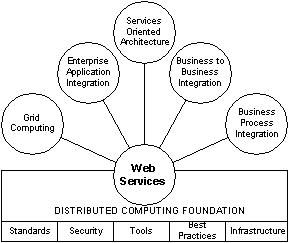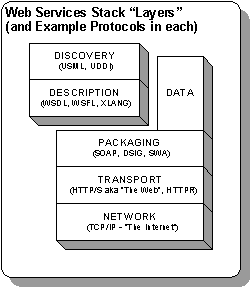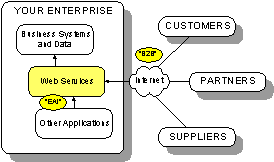
"It is
impossible for ideas to compete in the marketplace if no forum for
� their presentation is provided or available." �������� �Thomas Mann, 1896
Is Web Service Technology a Good Fit for My Organization?
Author:
Jay Lee
Contributed
by eBI Solutions LLC
�
�
Overview
“Web
Services” is a term that can be defined in many ways and from many
perspectives. The following are but a few of the possible definitions.
From the perspective of…
...we might define web services as…
the development process of Web Services
the development and deployment tools used to create web services
the network infrastructure of Web Services
the network, server, and security requirements for hosting web services
the maturing standards by which to adopt, implement, and support Web Services
WS-Security, WS-Trust, WS-Policy
an acronym junkie
XML, HTTP, SOAP, DSIG, WSDL, UDDI, XLANG, WSFL, SWA, USML, DIME.
Acronyms
and varying perspectives aside, one very important question remains:
What
can Web Services do for my business?
Unfortunately,
there is no complete correct answer to this question. Though the growth and
adoption of Web Services in business hinges upon the convergence of a
“generally accepted” set of industry standards, today’s myriad of
overlapping, and sometimes divergent, standards do not help this cause.
The following pages will outline some basic concepts, and entertain a few simple questions, to help you form a more coherent view of Web Services.� The goal of this paper will be to help place your organization at the beginning of a roadmap to successful adoption of Web Services as part of your application integration strategy.
What
are Web Services?
The
“executive elevator pitch”
“Web
Services” technology defines a new strategy of application integration
which uses the tried and true transport technology, HTTP, and widely
accepted data formatting standard (XML) with which to:
a)����� Build self-contained business functions and services
b)����� Access business functions within existing enterprise systems, and in within partner organizations.
There
exist today a powerful, yet “organic” grassroots movement to construct
open standards in an effort to forge a common language with which
organizations can communicate and interact with each other.
Beyond
the hype of the technology itself, “Web Services” is a mix of standards
and processes with which to employ already widely adopted technologies
(HTTP, XML) as a means for translating and transporting business data while
leveraging the investments in business functionality that exist within
internal business systems. The standards-based nature of Web Services
provides the investment protection to mitigate the risks inherent to
adopting new technologies.
The
Reach of Web Services
Figure 1: Web Services foundation and its potential reach.
Though its concept remains simple, Web Services will be an enabler of many new and existing business and computing concepts such as Grid Computing, EAI, and Business Process Management/Integration. Business value from such services, which require a distributed computing architecture, can more easily be realized within and between enterprises.
The
“layers” of Web Services standards
�
�
Figure 2: The Web Services Stack.
This model is often referenced when identifying the
"layer" in which a protocol or standard operates.
The
sheer number of Web Services standards and protocols in use today can make
it difficult to understand where they all fit into the big picture. It is
easiest to classify Web Services standards into one of five “layers” of
the protocol stack (for those of you with backgrounds in network management,
this is similar to the OSI 7-layer reference model)
Discovery
protocols facilitate the location of the appropriate Web Service for the purpose intended, or the functionality sought by a client. Available Web Services are listed in well-known global directories.
Description
of Web Services is done using languages such as WSDL (Web Service Description Language) to expose the Service’s public interface.
Packaging
SOAP (Simple Object Access Protocol) is today’s most commonly adopted standard for packaging Web Services data. Several extensions to SOAP also exist to address security, message routing, and binary or MIME attachments.Transport
This layer describes the protocol used to transport data of Web Service between client and server. HTTP (Hypertext Transport Protocol) is the most commonly used protocol, with extensions available, which address security (HTTPS) and reliability (HTTPR).Network
This layer describes the protocol used by the end computers to move the data. This is usually done over the Internet (using TCP/IP).Web
Services - Definition
For the sake of keeping this document focused on the question, “Is Web Service technology a good fit for my organization?” we will refrain from providing any detailed technical definition of Web Services. WebServices.Org (http://www.webservices.org) provides excellent resources and white papers to describe Web Services technologies, protocols, standards, and current challenges.
WS-I (Web Services Interoperability - http://www.ws-i.org) provides resources to address interoperability between the myriad of Web Services standards currently being proposed.
What
are the limitations of First Generation Web Services?
Competing
standards
There
are both “Top-Down” efforts to standardize Web Services protocols, the
frameworks of which are governed by large organizations, and “Bottom-Up
efforts which are “grassroots” movements to standardize Web Services.
There are advantages to both, and it will take years�
before standards converge to a universally accepted set.
If
your organization can benefit from the capabilities of Web Services, don’t
wait for a convergence, or a perfect set, of standards. Even with standards
in flux, there’s much to gain in leveraging Web Services within your
organization. Be sure to understand the implications of being locked into a
standard.� Example;
Your largest partners impose different Web Services standards on their
partners, leaving you with no choice but to conform to theirs. If possible,
design or select Web Services solutions, which are flexible enough to
accommodate multiple standards, or are open enough to grow with changing
requirements in the foreseeable future.
Few,
if any, “complete packages of products” are available today
In
order to ensure that your organization’s web services infrastructure
provides a complete solution, you must ensure that each of the following
factors are addressed in selection process of each piece of your Web
Services strategy:
Technical Infrastructure.
Your IT organization must be able to support the network, servers, and operating systems required to communicate using the Internet and the World Wide Web within your enterprise and with your partner(s).
Development Tools.
As with most systems, you will need the proper development tools to ensure proper technical implementation of Web Services. The proper coding, version control, and deployment tools will be critical to managing Web Services development cycles.Management Tools.
Though individual Web Services are not difficult to create, when they become large in number, they can become unwieldy to manage. You will need ways to manage Partner relations (and the variations between standards used by different partners), monitor activity, and comprehensively address security issues. Due to the youth of Web Services and its yet-to-be widespread deployment, very few packages on the market today offer proper management tools. Be cautious in selecting the products or and solution packages that you choose to implement and eventually manage your web services.Security.
When evaluating Web Services, or any technology for this matter, and to ensure due diligence to the security of your business systems and data, you must ensure that the following simple questions are addressed� each step of the way, by each component implemented:Has the partner (a system, organization, or person) been explicitly allowed to access my web service?•�������� Authentication:
•�������� Authorization:
What is this partner, once authenticated, allowed to do?•�������� Confidentiality: Will knowledge, and details, of interactions with my partner(s) be kept private from outside parties?
•�������� Integrity:
Can I ensure that the data, which is exchanged with my partner(s), is not corrupted during the transport and exchange of data?•�������� Availability:
Can I guarantee to my partner(s) 100% uptime during critical business hours? What contingencies are in place to act, as a substitute for the services provided by the web service(s), should the systems they are hosted on be compromised?•�������� Non-Repudiation:
Can I guarantee that interactions with this partner cannot be impersonated by any outside party, allowing for full accountability of all transactions•�������� Audit:
Will reliable records and audit-trails of the transactions with my partner(s), and details the transactions, be available should the need arise?Where
will Web Services fit into my organization’s IT strategy?
Most businesses today use computers and software in one or more forms to manage their daily operations. They often end up with several disparate, isolated business applications, which cannot easily communicate with each other or exchange data efficiently and reliably.
�
�
Figure 3: Using Web Services for Enterprise Application Integration (EAI)
and Business-to-Business (B2B) interactions.�
EAI
(Enterprise Application Integration) tools of the past have addressed this
problem with proprietary connectors and adapters which require additional
coding using each particular vendor’s API’s. This leads to code, which
may not be readily reused by other systems you wish to integrate. Many
e-business products and solutions employ EAI tools, while also providing the
tools to facilitate communication with partner organizations (B2B -
“Business-to-business” interactions).
Web Services provides a more open interface with which you can
expose the functionality of your isolated applications to applications used
in other departments within your organization or to select partners with
whom B2B automation would make sense.
�
�
Figure 4: A Self-Contained Web Service
providing service, data, or intangible products to customers.�
Web
Services technology can also be used as a foundation for
“self-contained” business functions (rather than as just a means to
integrate functionality of pre-existing systems).
You may choose to build such a service from the ground up as an
intangible product, service, or data offering. Open standards ensure that
prospective customers can easily communicate with your Web Service without
acquisition of proprietary Application Programming Interfaces (APIs) or
Software Development Kits (SDKs).
Why
adopt Web Services?
Leverage value of existing systems.
As with any integration solution, Web Services will allow you to use functionality, which was once locked into your business systems externally.Investment protection.
By investing resources in a technology, which is based on widely adopted protocols (such as HTTP, XML) you will not be stuck with any proprietary integration technologies as you once may have been with proprietary connectors and adapters of the past.Flexibility, Agility, Scalability.
Again, due to the standards-based nature of Web Services, you can scale horizontally to account for growing numbers of applications across the enterprise, which can access value delivered by a Web Services solution. You can also easily scale vertically to account for transaction volume.�
How
should my organization adopt Web Services?
Define
a Vision
When evaluating a new technology, product, or service, it is always important to first envision how your organization will best benefit from it. Which departments can benefit the most from automation and integration of processes? Which systems hold data, which can be leveraged by external applications or by your business partners, suppliers, or customers?
Build
a Roadmap
Start small, with a pilot.
Explore your organization’s IT resources and search for a unit of work that can be consumed by client applications as a Web Service. The value of implementing a Web Service for this unit of work should be quantifiable. This value may come from the elimination having to manually perform a repetitive task, reduction of human errors and omissions, or in the service’s ability to scale to multiple disparate clients without additional investment.Measure your returns.
Determine the returns on your initial investment, taking into account how the cost of ownership will scale as the number of Web Services scales.Review and, if necessary, revise your roadmap.
Determine whether the returns resulting from your Web Services investment can justify a large-scale deployment. You may find that the timing is not right for your organization to adopt Web Services technology, or that your IT organization is not ready to support it. If you decide that Web Services makes sense for you, revise your roadmap, adjusting for what you’ve learned in your pilot be ready to actPlan for scale.
Use what you’ve learned from your previous experience to determine what criteria to use when selecting products and services to help you scale, manage, and protect your Web Services investments.Act!
In the early stages of any new technology’s adoption lifecycle, we must accept that changes will happen. Build enough flexibility into your system to account for these changes. Don’t wait for the “perfect moment” to enter the Web Services playing field. As with any system with high potential returns on investment, time lost is money lost.
Commonly
used Web Services acronyms
�
�
Web Services Layer
Term /Acronym
Definition
Network
TCP/IP
Transmission Control Protocol / Internet Protocol
The Communications protocol used on the Internet.
Transport
HTTP
HTTPS
HTTPR
Hypertext Transport Protocol
Secure Hypertext Transport Protocol
Reliable Hypertext Transport Protocol
DIME
Direct Internet Message Transport
Packaging
SOAP
Simple Object Access Protocol
SOAP-DSIG
SOAP Digital Signatures (Security Extension of SOAP)
SWA
SOAP messages With Attachments
WS-License
Web Services License Language
WS-Referral
Web Services Referral Protocol - enables routing strategies for SOAP message paths
WS-Routing
Web Services Routing Protocol
WS-Security
Web Services Security Language - enables secure Web Services interaction, facilitating credential exchange, message integrity, and message confidentiality
Description
WSDL
Web Services Description Language
WSCL
Web Services Conversation Language
WSCM
Web Services Component Model
WSEL
Web Services Endpoint Language
WSFL
Web Services Flow Language
WSML
Web Services Meta Language
WSXL
Web Services Experience Language
WSUI
Web Services User Interface
XLANG
Web Services for Business Process Design
Discovery
UDDI
Universal Description, Discovery, and Integration
USML
USSI Search Markup Language
WS-Inspection
Web Services Inspection Language
�
�
�
�
�
�
�
�
�
�
�
�
�
About eBI Solutions LLC
eBI Solutions specializes in providing e-Business Integration solutions.
eBI Solutions provides eAI and B2B integration solutions to companies in the mid-market as well as Fortune 500 clients. Experience helps us to appreciate the challenges mid-size companies face, and to select relevant solutions for today and tomorrow, with an ROI and a budget that make sense.
While the primary focus is integration technology, an integration project is only successful when the team running it has an intrinsic understanding of the systems and business processes impacted by an integration project. Our approach to integration and selecting professionals for our projects clearly reflect that reality.
The Business Forum
Beverly Hills, California, United States of AmericaEmail:� [email protected]
Graphics by DawsonDesign
Webmaster:� bruceclay.com
��� Copyright The Business Forum Institute - 1982 - 2015� ** All rights reserved.
�The Business Forum Institute is not responsible for� the content of external sites.Read more



